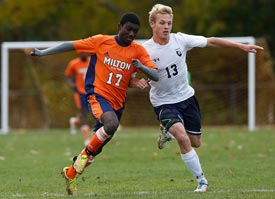The 2015 Boston storms shut down the whole metropolitan area and served up some new and daunting challenges, as well as some unanticipated ripple effects. Meanwhile, Milton Academy’s facilities, campus safety and dining services teams powered on. Milton faculty and students spied clear asphalt on the campus byways long before most sidewalks and roadways in Boston saw the light of day.
For each of our storms, two of facilities director Steve Zannino’s staff stayed the night and plowed out parking spaces prior to the other staffers’ arrival in the early hours of the morning (4 a.m.), so everyone could man the bobcats, sidewalk plows, and backhoe, clearing the Milton ways. Hours of blizzard conditions, or simply steady wind, snow and cold temperatures conspired against the consistent push to make passage open and safe across campus. Plenty of ice, and temperatures that refused to bump up beyond the teens, or low 20s on a balmy day, anchored the ice and snow in place.
While a scenario like this once or twice a winter—separated by a span of weeks—might be typical fare, three major storms at less-than-weekly intervals and several minor snow storms on the shoulder days made keeping the campus open and operating a near-heroic venture. A plan for the dorm faculty to move their cars so that large areas could be plowed efficiently (then return their cars close to the houses) proved to work very well. At certain times, administrators did need to resort to “stay in place” directives for kids and adults in the dorms, so that staff working outside in terrible visibility and driving snow could get the job done and keep students safe. Two roofing contractors helped Milton’s facilities crew deal with snow on the academic buildings and residential buildings.
“We all know it’s our responsibility to clear the campus,” Steve says, “and it’s almost a contest against the elements to reach the pavement. The men see what they do as a matter of pride, now. Plenty of Milton staff driving from home to School have remarked on how much more navigable the campus is than their own neighborhoods.”
Communication with various teams was essential to keeping everything going, and Campus Safety drove that effort. Using Milton’s RAVE alert system, Campus Safety could let particular dorms know when dining services would arrive, or manage the re-parking of faculty cars, or begin and end the “stay in place.” Milton was able to use the RAVE alert to let parents on certain bus routes know when and by how much the buses would be late. Traffic in metro-Boston has been impossibly slow, due to narrow streets, and towering piles of snow at every intersection.
“This situation allowed us to explore what RAVE could do for us. Pulling together user groups, like faculty in particular dorms, on a need-to-know basis, and alerting them with important information, was a good exercise and helpful for the future,” says Jay Hackett, campus safety director. Milton’s “Command and Operation Center,” a room in the Student Center, is equipped to provide seamless access to information and communication and is a well-used resource. Fortunately, Milton didn’t lose power at any time, so the Center’s radio and phone assets weren’t required during these storms.
Dining services staff are also among the School’s essential employees. Flik dining services typically provides motel options near campus for dining staff, in these kind of emergencies. Roughly 20–25 dining staff members support the dining service in non-peak hours. Food is delivered to dorms on East Campus and the Hallowell-Millet-Norris quad; during snow storms, some dinners may become “Forbes only” events. A happy, surprise delivery of chicken nuggets and French fries cheered up the stay-in-place teenagers on one snowbound afternoon.
Trying to track storms with enough precision to make sure the right number of staff are on campus at the right time is the hardest part of storm response, according to Steve Zannino and Jay Hackett. Even harder, though, is the awareness that after long hours outside, devoted to making the campus open and safe, Milton facilities, campus safety and dining staff must return to their own houses and families and do the whole thing over again—tackle snow on roofs and walkways, with ice dams and leaks. When the seasons move on and the playing fields see the players, Milton staff will be among those in New England sharing amazing stories about this historic winter.


